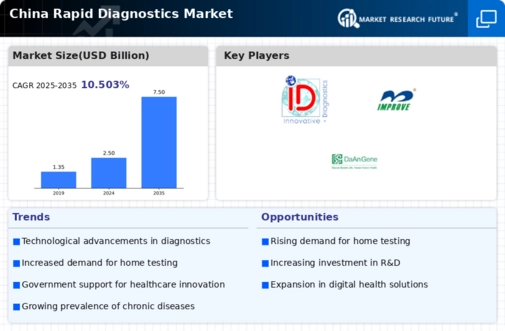Increasing Consumer Awareness
Consumer awareness regarding health and wellness is on the rise in China, significantly impacting the rapid diagnostics market. As individuals become more informed about the importance of early detection and preventive healthcare, the demand for rapid diagnostic tests is likely to increase. Educational campaigns and health initiatives are contributing to a shift in consumer behavior, with more people seeking out testing options for various health conditions. This trend is particularly evident in the context of chronic diseases, where early diagnosis can lead to better management and outcomes. The rapid diagnostics market is well-positioned to capitalize on this growing awareness, as consumers actively seek reliable and efficient testing solutions to monitor their health.
Growing Healthcare Expenditure
The rapid diagnostics market in China is experiencing a notable boost due to the increasing healthcare expenditure. The Chinese government has been investing heavily in healthcare infrastructure, with spending projected to reach approximately $1 trillion by 2025. This investment is likely to enhance the accessibility and availability of rapid diagnostic tools across various healthcare settings. As healthcare facilities expand and modernize, the demand for efficient diagnostic solutions is expected to rise. Furthermore, the emphasis on preventive healthcare and early disease detection aligns with the capabilities of rapid diagnostics, thereby driving market growth. The rapid diagnostics market is poised to benefit from this trend, as healthcare providers seek to improve patient outcomes through timely and accurate testing.
Supportive Government Policies
Government policies in China are playing a pivotal role in shaping the rapid diagnostics market. The Chinese government has implemented various initiatives aimed at promoting healthcare innovation and improving public health outcomes. Policies that encourage research and development in diagnostic technologies are likely to foster a conducive environment for market growth. Additionally, the government's focus on enhancing healthcare access in rural areas is expected to drive demand for rapid diagnostics, as these tools can be deployed in settings with limited resources. The rapid diagnostics market stands to gain from these supportive measures, as they facilitate the introduction of new products and technologies that meet the evolving needs of the healthcare system.
Rising Incidence of Infectious Diseases
The prevalence of infectious diseases in China is a significant driver for the rapid diagnostics market. With urbanization and population density increasing, the transmission of infectious diseases has become a pressing concern. Reports indicate that the incidence of diseases such as tuberculosis and hepatitis remains high, necessitating rapid and accurate diagnostic solutions. The rapid diagnostics market is responding to this need by developing innovative testing methods that can deliver results in a matter of minutes. This urgency for quick diagnosis is crucial in controlling outbreaks and ensuring effective treatment. As the healthcare system prioritizes rapid response capabilities, the market for rapid diagnostics is likely to expand, reflecting the growing demand for these essential tools.
Technological Innovations in Diagnostics
Technological advancements are reshaping the landscape of the rapid diagnostics market in China. Innovations such as point-of-care testing and mobile health applications are enhancing the efficiency and accuracy of diagnostic processes. The integration of artificial intelligence and machine learning into diagnostic tools is also gaining traction, potentially improving the speed and reliability of test results. The rapid diagnostics market is witnessing a surge in the development of user-friendly devices that can be utilized in various settings, including remote areas. This trend not only facilitates timely diagnosis but also aligns with the increasing demand for accessible healthcare solutions. As technology continues to evolve, the market is expected to expand, driven by the need for rapid and reliable diagnostic capabilities.














Leave a Comment